Ever wondered what makes Cockatoos of Australia so special? These birds, part of the Cacatuidae family, are a natural wonder. They stand out with their unique looks and interesting ways. Cockatoos have won the hearts of bird lovers everywhere. But what makes them unique, and where can you see them in the wild? Let’s dive into the world of Australian cockatoos and learn about their charm.
Introduction to Cockatoos
Cockatoos are a fascinating group of parrots. They belong to the Cacatuidae family within the Psittaciformes order. These birds are known for their big crests and strong, curved beaks. There are 21 species across 8 genera, found mainly in Australia and parts of Indonesia, New Guinea, and the Solomon Islands.
What are Cockatoos?
Cockatoos are part of the parrot family. They stand out with their big, fan-like crests that they can move up and down. They also have a special toe setup, with two backward and two forward toes, helping them hold onto things.
Features of Cockatoos
Cockatoos have a wide range of colors, from all-white to bright yellow, pink, and black. Their beaks are strong for opening nuts and seeds. Their claws let them climb and move around easily.
These birds are smart and love to be with others, often living in close groups. They make sounds like screeching, and whistling, and can even copy human speech. This makes them very interesting to watch.
Species of Cockatoos in Australia
Australia is home to many cockatoo species, with the Genus Cacatua being one of the most well-known. The Sulphur-crested Cockatoo (Cacatua galerita) is a large, white bird with a bright yellow crest. It’s a common sight in this region.
Sulphur-crested Cockatoo (Cacatua galerita)
The Sulphur-crested Cockatoo lives along Australia’s east coast and in Papua New Guinea. It has several subspecies. These include the Triton Cockatoo (C. g. triton) in New Guinea, the Eleonora Cockatoo (C. g. eleonora) in the Aru Islands, the Mathews Cockatoo (C. g. fitzroyi) in northern Australia, and the Greater Sulphur-crested Cockatoo (C. g. galerita) from Cape York to Tasmania.
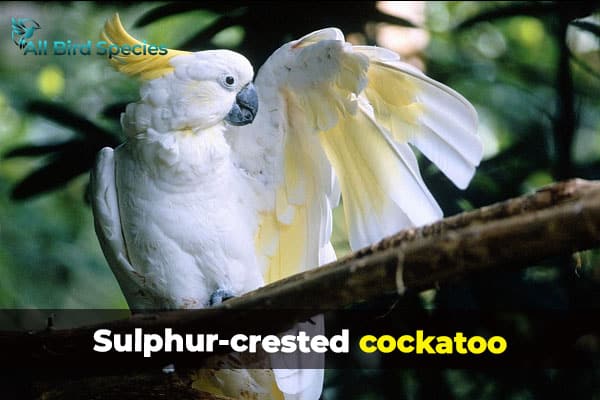
This bird is known for its large, powerful beak and dark eyes. Its vibrant yellow crest can be raised and lowered. In the wild, it can live up to 80 years. In cities, it’s often seen as a pest because it damages timber decking and paneling on houses.
| Subspecies | Distribution | Appearance |
|---|---|---|
| Triton Cockatoo (C. g. triton) | New Guinea | Large, white cockatoo with yellow crest |
| Eleonora Cockatoo (C. g. eleonora) | Aru Islands | Large, white cockatoo with yellow crest |
| Mathews Cockatoo (C. g. fitzroyi) | Northern Australia | Large, white cockatoo with yellow crest |
| Greater Sulphur-crested Cockatoo (C. g. galerita) | Cape York to Tasmania | Large, white cockatoo with yellow crest |
The Sulphur-crested Cockatoo is known for its loud call and for being a pest in cities. Yet, it’s a beloved bird in Australia. It’s known for its intelligence, playful nature, and striking look.
Cockatoos in Australia
Australia is a paradise for cockatoo lovers, with many species to discover. The Little Corella, Long-billed Corella, and Western Corella stand out. Each has its own look and where it lives.
Little Corella (Cacatua sanguine)
The Little Corella is a small white parrot with blue eye rings and a pink patch near its beak. It has a yellow wash on its underwing and undertail. You can find it in Australia and New Guinea, in many places from deserts to cities.
Long-billed Corella (Cacatua tenuirostris)
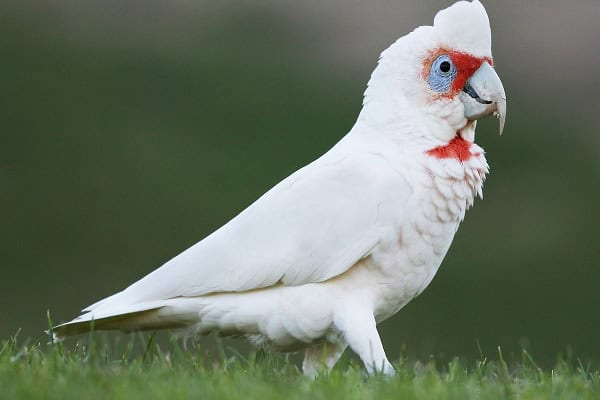
The Long-billed Corella is a bit bigger and has white feathers, a dark eye, and a blue ring around it. It also has reddish-pink patches near its beak and on its chin. This parrot lives in southeastern Australia, in places like grasslands and parks.
Western Corella (Cacatua pastinator)
The Western Corella is a small parrot with a tiny crest. It’s white and has a pink mark between its eyes and a light beak. Its underwing and undertail are yellow, and it has a dark eye with a blue ring. You’ll find it in southwestern Australia, in farmlands and wooded areas.
| Cockatoo Species | Distribution | Appearance |
|---|---|---|
| Little Corella (Cacatua sanguinea) | Australia and New Guinea | Small white parrot with blue eye rings, pink patch between eye and pale beak, and yellow wash on underwing and undertail |
| Long-billed Corella (Cacatua tenuirostris) | Southeastern Australia | Medium-sized parrot with white plumage, dark eye, pale blue eye ring, and reddish-pink patches on the chin and between the eye and pale beak |
| Western Corella (Cacatua pastinator) | Southwestern Australia | Small parrot with white plumage, a tiny crest, pink marking between the eyes, and yellow-tinted underwing and undertail |
Other Australian Cockatoo Genera
Australia is home to more than just the Cacatua genus of cockatoos. The country also has the Genus Callocephalon and Genus Calyptorhynchus. These groups add to Australia’s rich bird life.
Genus Callocephalon
The Gang-gang Cockatoo lives in the southeastern parts of Australia. It’s a small parrot with a greenish-grey body. The males have a red head and crest, making them stand out in forests and yards.
Genus Calyptorhynchus
Black Cockatoos belong to the Genus Calyptorhynchus. They are found only in Australia. There are five species, like the Glossy Black Cockatoo and the Red-tailed Black Cockatoo. These birds are known for their black feathers and unique tails with red or yellow panels.
| Calyptorhynchus Species | Subspecies | Conservation Status |
|---|---|---|
| Red-tailed Black Cockatoo (Calyptorhynchus banksii) | 4 subspecies | Habitat modification and clearing for agriculture or forestry are the main threats |
| Yellow-tailed Black Cockatoo (Calyptorhynchus funereus) | 2 subspecies | Declining due to land clearing for development |
| Glossy Black Cockatoo (Calyptorhynchus lathami) | 2 subspecies | Under pressure from developmental land clearing in parts of Queensland and New South Wales |
| Carnaby’s Black Cockatoo (Calyptorhynchus latirostris) | 1 subspecies | Destruction of remnant eucalypt woodlands has impacted the population size |
| Baudin’s Black Cockatoo (Calyptorhynchus baudinii) | 1 subspecies | Listed as Endangered in 2018 |
The Calyptorhynchus genus shows the amazing variety of Black Cockatoos in Australia. Each species has its own look and faces its own challenges.
Behavior and Traits of Cockatoos
Cockatoos are famous for their loud calls and smart nature. They range from 12 to 24 inches tall and weigh about 1.7 pounds. Their loud calls can be heard up to 3 miles away, helping them stay in touch with their group.
Vocalizations and Intelligence
Cockatoos are very smart and can learn quickly. In cities, some have figured out how to open trash bins for food. Others even dance to music in their cages. These skills show how clever these birds are.
Breeding and Nesting
In Australia, cockatoos breed during certain seasons. In the south, it’s from August to January, and in the north, from May to September. They live in tree hollows and both parents take care of the eggs and the young ones. The young ones stay with their parents for a few months, learning important skills.
Cockatoos are known for being playful, affectionate, and faithful pets. But, they need a lot of mental and physical activity to be happy. Without it, they might start picking at their feathers. By knowing what they need, we can make sure they are happy, whether they are in the wild or with us.
Cockatoos as Pests
Cockatoos, with their charming looks and sweet personalities, are loved by many. However, they can be a big problem in some parts of Australia. They have become too many in some areas, causing damage to crops, fruit, and young trees. They also harm outdoor structures.
This has made them pests in agriculture. To control their numbers, some cockatoos are culled, needing permits because they are protected. In cities, they cause trouble by damaging buildings and outdoor items. To make things worse, feeding them can make the problem bigger.
| Pest Cockatoo Species | Impacts | Management Strategies |
|---|---|---|
| Sulphur-crested Cockatoo (Cacatua galerita) | Extensive damage to crops, orchards, and young tree plantations Destruction of soft timber on houses and other structures Interference with managed grass surfaces | Declared as a pest species in Western Australia Culling and population control measures with government permits Efforts to discourage public feeding in urban areas |
| Little Corella (Cacatua sanguinea) | Crop damage, particularly to cereal crops Destruction of young tree plantations Nuisance behavior in urban areas | Declared as a pest species in some regions Culling and population control measures with government permits Discouraging public feeding in urban areas |
Managing cockatoos as pests is a tough and debated topic. These birds can greatly affect both farms and cities. Finding a balance between protecting them and reducing their damage is a big challenge for authorities and communities in Australia.
Cockatoos in Aviculture
Cockatoos, like the Sulphur-crested Cockatoo, are popular in aviculture. These beautiful birds are bred in captivity, with the Eleonora and Triton subspecies being favorites. But, owning a cockatoo comes with its own set of challenges.
Care and Longevity
Cockatoos love to be social and enjoy chewing and making noise. They need a lot of time from their owners. But, they can live a long time, over 70 years in captivity. In the wild, they live about 20-40 years.
Health Concerns
Cockatoos can get a disease called psittacine beak and feather disease. This makes them lose feathers and grow abnormal beaks. It happens in the wild and can happen to captive birds too. Keeping them healthy means regular vet visits and careful care.
| Cockatoo Species | Average Lifespan in Captivity | Susceptibility to Psittacine Beak and Feather Disease |
|---|---|---|
| Sulphur-crested Cockatoo | 70+ years | High |
| Umbrella Cockatoo | 60-80 years | Moderate |
| Moluccan Cockatoo | 50-70 years | High |
| Citron-crested Cockatoo | 40-60 years | Moderate |
Having a cockatoo as a pet is a big responsibility. It takes a lot of time and effort. But, for those ready for the challenge, these smart and loving birds can be amazing friends.
Conservation Status
The conservation status of cockatoos in Australia is a mix. Many species are listed as Least Concern on the IUCN Red List, showing stable populations. But, some subspecies have seen big declines and are now threatened.
The Muir’s Corella is listed as Vulnerable because its numbers have dropped. In Australia, cockatoos are protected by law. You need a permit to cull or manage them. This helps protect these birds, but threats like habitat loss and human-wildlife conflicts are still there.
| Species | Conservation Status | Population Trend |
|---|---|---|
| Carnaby’s Black Cockatoo | Endangered (IUCN 2022) | Declining |
| Baudin’s Black Cockatoo | Critically Endangered (IUCN 2022) | Declining |
| Forest Red-tailed Black Cockatoo | Vulnerable (EPBC Act) | Declining |
| South-eastern Glossy Black Cockatoo | Vulnerable (Australia) | Declining |
| Yellow-tailed Black Cockatoo | Secure (Australia), Vulnerable (South Australia) | Declining |
Cockatoos in Australia face many threats, like losing their homes and fighting for nesting spots. They also struggle with less food. Conservation efforts, like fixing habitats, working with communities, and research, are key to protecting these amazing birds for the future.
Cockatoos in Australia (Cacatuidae Family)
Cockatoos, along with corellas and the Cockatiel, form a diverse group of parrots in the Cacatuidae family. They are mainly found in Australia but also in the Philippines, Indonesia, New Guinea, and the Solomon Islands. These birds are known for their big crests, strong beaks, and special toe setup that helps them hold onto things.
The Cacatuidae family has 21 cockatoo species, making it the only family in the superfamily Cacatuoidea. These birds are bigger than many other parrots, measuring 30-60 cm long and weighing 300-1,200 grams. They live from the Philippines to Australia, in forests, woodlands, parks, and even cities.
Cockatoos eat a mix of seeds, tubers, corms, fruit, flowers, and insects. They often eat in big groups and are known for being monogamous, staying with one partner for many years. They also like to come back to the same places to nest year after year.
However, some cockatoo species are facing big challenges, like illegal bird trade. This is making their numbers go down in the wild. It’s important to spread the word about protecting these Australian birds and their homes.
| Cockatoo Species | Distribution | Habitat |
|---|---|---|
| Sulphur-crested Cockatoo (Cacatua galerita) | Eastern Australia, Tasmania | Forests, woodlands, parks, urban areas |
| Little Corella (Cacatua sanguinea) | Inland eastern and northern Australia | Woodlands, grasslands, urban areas |
| Long-billed Corella (Cacatua tenuirostris) | Southwestern Australia | Woodlands, grasslands, urban areas |
| Western Corella (Cacatua pastinator) | Southwestern Australia | Woodlands, forests, urban areas |
Cockatoos are key to Australia’s ecosystems, helping to spread seeds and keep forests and woodlands healthy. Their unique traits and behaviors make them a cherished part of Australia’s bird life.
Check Our Previous Articles
| Hummingbird Tattoo Meaning |
| Spiritual Meaning of Dead Birds |
| Birds With Yellow Bellies |
| What is a Group of Turkeys Called? |
| Easter Egger Rooster Vs Hen: Key Differences |
Final Thoughts:
The cockatoos of Australia’s Cacatuidae family are truly fascinating birds. They stand out with their big crests and strong beaks. Their smartness and ability to adapt have made them popular around the world.
Some cockatoos have become pests in cities, but they play a big role in Australia’s nature. They show how well they can learn and share new ways to find food. This shows they are as smart as great apes.
As people in Sydney try to keep their trash safe, the cockatoos keep finding new ways to get to it. This shows how they keep adapting and surviving.
The future of cockatoos in Australia is not clear, but they are important for birds and nature. By learning more about them, we can reduce conflicts with humans. The cockatoos show how nature can be resilient and inspiring.


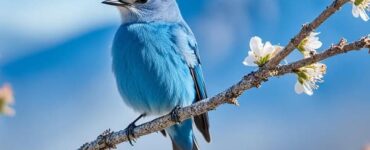
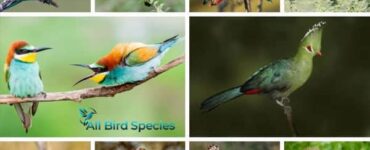
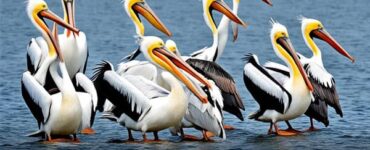
Add comment